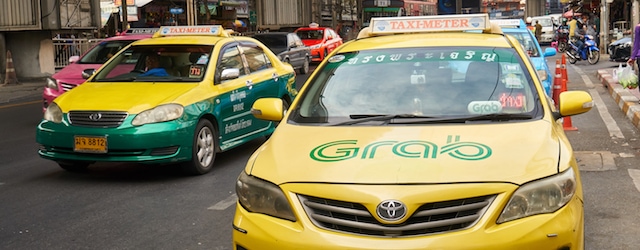As Asia ditches cash for digital wallets, more citizens are able to join the financial economy—and they are delighted.

|
Asia-Pacific Innovators 2018 |
|
|---|---|
|
Financial Innovator |
DBS Bank |
|
Corporate Innovator |
Grab |
|
Individual Innovator |
Masayoshi Son |
Asia is synonymous with innovation, as symbolized by the extraordinary transformation of China’s economy from a state-dominated agricultural behemoth to a technology-driven economy rivaling East Asian counterparts such as Japan. The economy has grown by an average of 9.63% from 1989 to 2018, according to Trading Economics; and global brands including Huawei, Alibaba and WeChat are widely acknowledged to have disrupted their respective markets.
China is hardly alone. Asia as a whole is experiencing something of an innovation renaissance. Last year it ranked as the world’s most innovative region, with 45 companies among the Top 100 Global Innovators, according to Clarivate Analytics. Examples abound: South Korea built its economy on the back of big companies like Hyundai, LG and Samsung. But historically, there has been little room for small and medium-size enterprises (SMEs) to flourish and grow. That is now changing.
The South Korean government has set up 17 innovation centers around the country, with start-up hubs supporting R&D in technology spanning the Internet of Things, biotech, 5G, Cloud and fog computing, Big Data and artificial intelligence (AI). Korea’s determination to develop a thriving SME sector based on technological innovation has rubbed off on other countries, with hubs springing up all over Asia. Yet ironically, Asia’s biggest area of disruption and innovation stems from one of its greatest weaknesses—lack of quality infrastructure for banking and Internet.
As a result, the so-called digital revolution is touching every socioeconomic layer, most notably in payment solutions, where Asia has emerged as a payments-innovation hub. Cash is still king throughout much of the region, though the market is rapidly tilting. The number of non-cash transactions in Asia is expected to reach 276.8 billion by 2020, according to the World Payments Report 2017.
For Asia’s digital creatives, innovation isn’t just about new financial solutions, but also about promoting financial inclusion where the “unbanked” represent a significant segment. The Philippines—where much of the population is dispersed outside urban centers, with little access to financial services—leads Asia in digital payments by smartphone. Unsurprisingly, mobile payments are encroaching on traditional banking. To seize back share, banks will need deeper engagement with customers. That’s where banks such as ANZ and Pakistan’s Meezan are developing solutions.
“We believe the future isn’t competing against other banking and finance companies,” says Neal Cross, chief innovation officer at DBS, “but pivoting ourselves to compete against technology companies which are constantly redefining customer experience.”
DBS, Southeast Asia’s largest bank by market capitalization, has been an early adopter of digital innovation, driven by the simple notion that banks of tomorrow will be radically different from the banks of today. Whether that has meant embracing Big Data, biometrics or AI, its focus for more than three years has been on using data to better understand customers. That journey has driven a cultural shift, as DBS evolved from its sales-led strategy to one where the bank assists customers with their decisions, which led us to name DBS the 2018 Financial Innovator—Asia-Pacific.
Consumer trust remains one of the few differentiating factors for banks. For DBS, that meant developing a digital platform
that maps customer behavior, with the goal of preventing one million problems by 2020. DBS built a real-time monitoring platform for its mobile-only bank in India, Digibank India, based on behavioral data that tracks nine high-impact features. DBS says the platform allows it to address customer pain points.
Analytics without enhancing the customer experience is probably counterproductive. Last year, DBS launched an API developer portal with the intent to raise engagement levels for both business-to-consumer and business-to-business organizations. “This boosts the bank’s lead in creating customer-centric experiences, by making available a wide array of APIs for other brands, corporates, fintechs and software developers to plug into,” says DBS’s Cross. A key difference with DBS’s API initiative is that it established development teams that collaborated with partners to co-create services and working prototypes. DBS has done that successfully with several organizations, including PropertyGuru, the largest property portal in Southeast Asia. Through such partnerships, DBS is able to extend its services beyond banking.
Ride Payments and Beyond
Partnerships also give an edge to our Corporate Innovator—Asia-Pacific. Singapore-based Grab has moved beyond mere transportation to promote financial inclusion in mobile payments and offer other revenue-enhancing tools for drivers and passengers. Innovation allowed Grab to edge out archrival Uber in a deal that saw the US competitor retreat from Southeast Asia after taking a 27.5% stake in Grab’s business.
Last year, Grab launched peer-to-peer fund transfers to let users of GrabPay’s mobile wallet instantly transfer credits between each other. Grab is extending the feature to include cashless transactions for merchants, typically in food and beverage, retail and entertainment. Grab believes it can drive mass adoption of mobile payments across Southeast Asia, but that it might require external support to reach the widely dispersed consumer base. Grab’s ability to execute in a multicultural region has won it backing from major investors, including US$2 billion from Didi Chuxing and SoftBank. “We have a stake in educating and bringing local communities into the cashless future, and are open to working with public and private-sector organizations to enable this,” says Jason Thompson, head of GrabPay.
Its entry into fintech has spawned microloans and insurance options for Grab drivers and businesses that use GrabPay. In April, Grab Singapore teamed up with Mediacorp to co-create tailored content for viewing on Grab’s in-car tablets, using Mediacorp’s distribution to give Grab’s passengers high-quality content for free.
The initiative is part of Grab’s advertising strategy, enabling drivers to earn passive income on top of fares. Started in March 2017, it has collectively generated more than S$300,000 (US$ 223,783) for drivers, Grab claims. That’s a nice bonus, even if it isn’t in cash.



